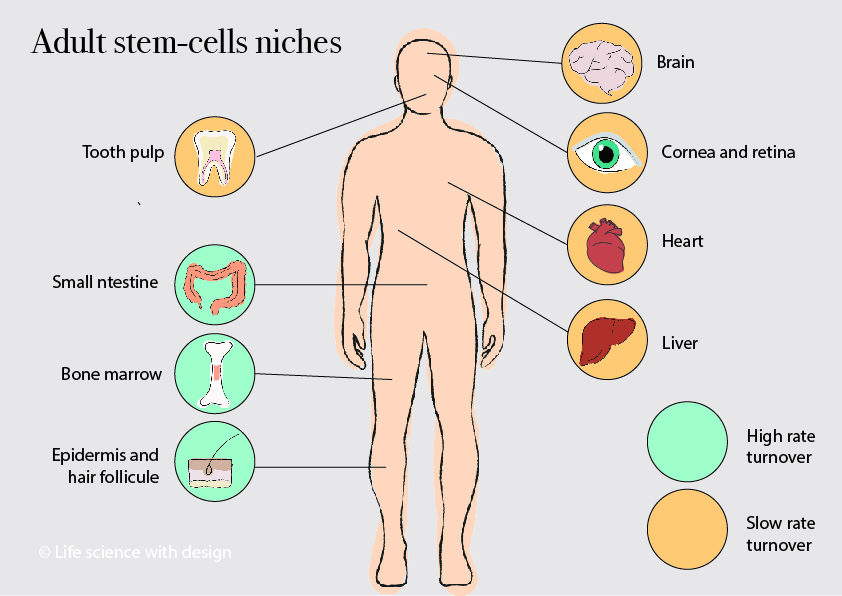
Adult stem cells have emerged as a remarkable and promising resource in regenerative medicine. Unlike embryonic stem cells, adult stem cells are found in various tissues and organs of the human body, contributing to tissue repair and regeneration throughout our lives. This article explores adult stem cells’ fascinating world, characteristics, applications, and potential for revolutionizing medical treatments.
Understanding Adult Stem Cells: Adult stem cells, also known as somatic or tissue-specific stem cells, are undifferentiated cells in specific tissues or organs in the body. They can self-renew and differentiate into specialized cell types, contributing to the maintenance and repair of the tissue in which they reside. Unlike embryonic stem cells, which can differentiate into any cell type, adult stem cells are more limited in their differentiation potential, typically giving rise to cells of their tissue of origin.
Characteristics of Adult Stem Cells: Adult stem cells possess several unique characteristics that make them particularly valuable for medical research and applications:
- Self-renewal: Adult stem cells can divide and replicate themselves while maintaining their undifferentiated state. This ability ensures a sustainable source of stem cells for regenerative purposes.
- Differentiation potential: Adult stem cells can differentiate into specialized cell types specific to the tissue in which they are found. For example, hematopoietic stem cells in the bone marrow can differentiate into various blood cell types.
- Plasticity: Recent research suggests that adult stem cells may possess a degree of plasticity, meaning they can differentiate into cell types outside their tissue of origin. This plasticity opens up new possibilities for their application in treating diseases and injuries.
Sources of Adult Stem Cells: Adult stem cells can be found in various tissues and organs throughout the body, including bone marrow, adipose tissue (fat), brain, liver, skin, and muscle, among others. These sources provide a readily accessible supply of adult stem cells for research and potential therapeutic purposes.
Applications in Medicine: Adult stem cells’ versatility and regenerative potential have generated considerable excitement within the medical community. Some of the notable applications of adult stem cells include:
- Hematopoietic Stem Cell Transplantation: Hematopoietic stem cells, derived from bone marrow or peripheral blood, are widely used to treat blood-related disorders such as leukemia, lymphoma, and other immune system disorders.
- Tissue Regeneration: Adult stem cells have shown great promise in regenerating damaged or diseased tissues. For instance, mesenchymal stem cells (MSCs) derived from bone marrow or adipose tissue have been used to treat conditions like osteoarthritis, heart disease, and spinal cord injuries.
- Organ Transplantation: The shortage of organs for transplantation is a significant challenge in medicine. Adult stem cells hold the potential to generate functional organs in the laboratory, paving the way for personalized organ transplantation and eliminating the need for donor organs.
- Drug Testing and Disease Modeling: Adult stem cells provide a valuable tool for studying diseases and testing potential therapies. By reprogramming adult cells into induced pluripotent stem cells (iPSCs), researchers can generate specific cell types affected by a disease, enabling the study of disease mechanisms and the development of targeted treatments.
Challenges and Future Directions: While adult stem cells offer immense potential, several challenges need to be addressed for their widespread clinical application:
- Limited differentiation potential: Adult stem cells have a more restricted differentiation potential than embryonic stem cells. Overcoming this limitation and enhancing their plasticity is an active area of research.
- Ethical considerations: Unlike embryonic stem cells, using adult stem cells does not raise ethical concerns. However, collecting and isolating adult stem cells from tissues may still present ethical dilemmas and require careful consideration.
- Safety and efficacy: Further research is needed to ensure the safety and efficacy of adult stem cell-based therapies. Factors such as immune rejection, tumor formation, and long-term effects must be thoroughly investigated.
- Standardization and scalability: To translate adult stem cell therapies into routine clinical practice, standardized protocols for isolation, expansion, and differentiation are essential. Additionally, scaling up production to meet the demands of large-scale treatments remains a challenge.
Adult stem cells hold tremendous promise for regenerative medicine, offering the potential to revolutionize the treatment of numerous diseases and injuries. Their ability to self-renew and differentiate into specialized cell types provides new avenues for tissue repair and organ regeneration. Continued research and advancements in this field will unlock the full potential of adult stem cells, ultimately improving the quality of life for countless individuals worldwide.

3 replies to "Adult Stem Cells: A Promising Frontier in Regenerative Medicine"
Sounds interesting tell me more thanks for the great article
Hi Dino
Thank you, Mr. David Booth!